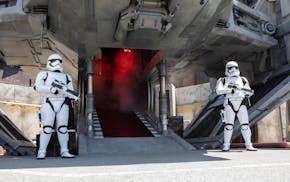Is there an ideal Christmas streetscape? Of course. But it's probably not the one you knew growing up.
Our storybook version of Christmas is a Victorian streetscape in Merrie Olde England, subset Jolly Olde London. It's night; hissing gas lamps cast a warm glow over the freshly fallen snow. The windows are lit, and if you peek through the glass you see overdressed people making merry. Perhaps there's a goose in the window, eyed by some urchin. Men in top hats with thick scarves are hurrying along.
How did that come to be?
Why doesn't our ideal Christmas look like 1962, with a big aluminum tree spot-lit by a Penetray Color Wheel?
Because … well, because it didn't turn out that way, thanks to a book, and movies made from it.
As the Cliffs Notes version of Christmas history has it, the mid-19th century wasn't too keen on Christmas celebrations. The Industrial Revolution had reset the agrarian pace of English life, and people were crammed 20-to-a-room in tenements, where everyone was dirty and coughed a lot. No one could afford gifts. Who'd want Christmas under those circumstances?
When Charles Dickens wrote "A Christmas Carol" in 1843, it revived Christmas as a holiday, and carved in stone Dickens' Victorian Christmas as the model for Christmases future.
He had some help. By the time he wrote his marvelous story, Christmas was starting to take on some of the trappings we know today. Prince Albert, a German, had introduced Britons to the idea of the Christmas tree. Carols were becoming more popular each year. And the sense that the modern world had thrown society off kilter — producing great wealth and such poverty — made people yearn for unifying traditions.
Dickens alone didn't revive Christmas, but he gave oxygen to the cultural yearning for the stability a tradition provides.
So when we idealize Dickensian streetscapes for Christmas tableaus, we're looking back to an age that worried about its lost connections to old traditions — just like we always do.
The midcentury model
There's another version of the Christmas landscape that means just as much to Americans. Unfortunately, it's as dead and gone as Dickens' world: the downtown department store window.
In the 1940s and '50s, downtown Minneapolis was the picture of city sidewalks dressed in holiday cheer.
The windows of the department stores were stuffed with toys and clothes. There were bell-ringers, shoppers balancing packages, trolleys rumbling along, movie marquees, neon signs — and a vitality that nothing we have today can match.
Malls just aren't the same. Online shopping, to state the obvious, is private and quiet; it's the difference between a rugby game and playing solitaire on your computer.
Amazon may have a million pages of toys, but it doesn't have the same effect as 10 toys in a shop window with a train running around behind the glass.
It's possible that in a hundred years people will come to view the midcentury Christmas in downtown U.S.A. the way we do the Victorian English one. Until then, we'll probably keep decorating with Victorian cliches, watch a Scrooge movie, and revisit an "ideal" time.
Bah! And humbug, too.
James Lileks • 612-673-7858
@Lileks
Music Review: Anitta welcomes listeners into her 'Funk Generation' on new album
Ask Amy: Give up on estranged brother



